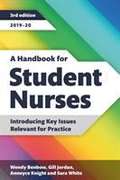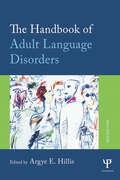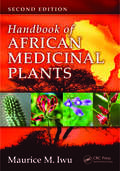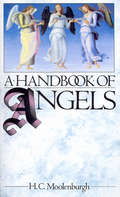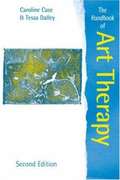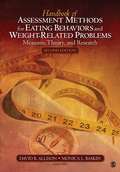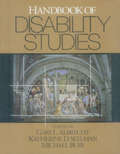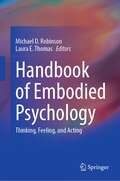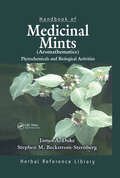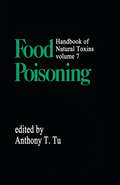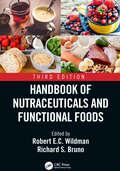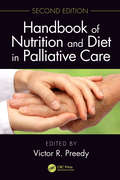- Table View
- List View
A Handbook For Student Nurses: Introducing Key Issues Relevant For Practice (3rd edition) (PDF)
by Wendy Benbow Gill Jordan Anneyce Knight Sara WhiteA Handbook for Student Nurses provides an introduction to the essential background knowledge that pre-registration nursing students need as a foundation for their training. This third edition reflects the new NMC standards of proficiency for registered nurses and the latest update of the NMC Code. Thoroughly revised and with a completely new chapter on health promotion, the book incorporates the latest developments in nurse education and in the health service.
Handbook of Acute Pain Management
by Jennifer A. Elliott Howard S. SmithPain is a pervasive symptom present in multiple areas of medicine. It is imperative that physicians not only evaluate and diagnose the source of pain, but that they also recognize how to manage the actual pain symptoms with effective treatment. Handbook of Acute Pain Management is an essential reference for professionals to enhance their knowledge
The Handbook of Adult Language Disorders
by Argye E. HillisThe Handbook of Adult Language Disorders is the essential guide to the scientific and clinical tenets of aphasia study and treatment. It focuses on how language breaks down after focal brain damage, what patterns of impairment reveal about normal language, and how recovery can be optimally facilitated. It is unique in that it reviews studies from the major disciplines in which aphasia research is conducted—cognitive neuropsychology, linguistics, neurology, neuroimaging, and speech-language pathology—as they apply to each topic of language. For each language domain, there are chapters devoted to theory and models of the language task, the neural basis of the language task (focusing on recent neuroimaging studies) and clinical diagnosis and treatment of impairments in that domain. In addition, there is broad coverage of approaches to investigation and treatment from leading experts, with several authors specializing in two or more disciplines. This second edition focuses on characterizing the cognitive and neural processes that account for each variant of aphasia as a first step toward developing effective rehabilitation, given that aphasia is one of the most common and disabling consequences of stroke. The best and most authoritative handbook in the field, The Handbook of Adult Language Disorders is the definitive reference for clinicians and researchers working in the scientific investigation of aphasia.
The Handbook of Adult Language Disorders
by Argye E. HillisThe Handbook of Adult Language Disorders is the essential guide to the scientific and clinical tenets of aphasia study and treatment. It focuses on how language breaks down after focal brain damage, what patterns of impairment reveal about normal language, and how recovery can be optimally facilitated. It is unique in that it reviews studies from the major disciplines in which aphasia research is conducted—cognitive neuropsychology, linguistics, neurology, neuroimaging, and speech-language pathology—as they apply to each topic of language. For each language domain, there are chapters devoted to theory and models of the language task, the neural basis of the language task (focusing on recent neuroimaging studies) and clinical diagnosis and treatment of impairments in that domain. In addition, there is broad coverage of approaches to investigation and treatment from leading experts, with several authors specializing in two or more disciplines. This second edition focuses on characterizing the cognitive and neural processes that account for each variant of aphasia as a first step toward developing effective rehabilitation, given that aphasia is one of the most common and disabling consequences of stroke. The best and most authoritative handbook in the field, The Handbook of Adult Language Disorders is the definitive reference for clinicians and researchers working in the scientific investigation of aphasia.
Handbook of African Medicinal Plants
by Maurice M. IwuWith over 50,000 distinct species in sub-Saharan Africa alone, the African continent is endowed with an enormous wealth of plant resources. While more than 25 percent of known species have been used for several centuries in traditional African medicine for the prevention and treatment of diseases, Africa remains a minor player in the global natural
A Handbook Of Angels
by H C MoolenburghIn 1981 a sermon was given in Leiden in which the minister called angels, 'a forgotten group'. This book is an attempt to recall a forgotten group into the memory of everyone.We read so much these days about matters concerning the underworld, that we are inclined to forget that an enormous 'upper world' stretches out above us. A world which is also extremely active, and one which is increasingly beginning to intrude. In A Handbook of Angels the author recounts his survey of four hundred people and the spectacular results, which include reportings of real-life sightings of angels.It becomes apparent that, though we may have forgotten about angels, they have not forgotten about us. They are returning to human consciousness on a gigantic scale.
The Handbook of Art Therapy (PDF)
by Tessa Dalley Caroline CaseWhat is art therapy? How can art and therapy combine to help individuals understand aspects of their inner life? This new edition of The Handbook of Art Therapy is thoroughly revised and updated and includes new sections on neurobiological research, and a current review of literature and contemporary practice. It provides a comprehensive introduction to the field of art therapy in a variety of different settings. Caroline Case and Tessa Dalley draw on their experience of teaching and practising art therapy, concentrating on what art psychotherapists actually do, where they practice, and how and why art therapy is effective. First-hand accounts of the experience of art therapy from both therapists and clients are used throughout, enriching the discussion of subjects including: the art therapy room art and psychoanalysis art therapy and creativity working with groups in art therapy art therapy with individual patients This straight-forward and highly practical Handbook will be invaluable not only as an introduction to the profession but also as a reference for students of art psychotherapy both during and after their training.
Handbook of Assessment Methods for Eating Behaviors and Weight-Related Problems (PDF): Measures, Theory, and Research
by David Allison Monica BaskinA thoroughly up-to-date reference for researchers who specialise in obesity and clinicians who specialise in working with clients with problem eating behaviours
The Handbook of Cannabis Therapeutics: From Bench to Bedside
by Ethan B. Russo Franjo GrotenhermenLearn the facts behind the pharmacology and pharmacokinetics of controversial cannabis therapeuticsThe Handbook of Cannabis Therapeutics: From Bench to Bedside sets aside the condemnation and hysteria of society&’s view of cannabis to concentrate on the medically sound aspects of cannabis therapeutics. The world&’s foremost experts provide a reasoned, thoroughly researched overview of the controversial subject of cannabis, from its history as a medicine through its latest therapeutic uses. The latest studies on the botany, history, biochemistry, pharmacology, toxicology, clinical use for various illnesses such as AIDS, epilepsy, and multiple sclerosis, and side effects of marijuana are all examined and discussed in depth. This comprehensive resource is a compendium of articles from the Journal of Cannabis Therapeutics-with additional contemporary commentary. It presents startling research that explores and supports the medicinal value of cannabis use and its derivatives as a valid therapeutic resource for pain and inflammation, for several illnesses less responsive to other therapies, and even for certain veterinary uses. Cannabinoids such as nabilone, THC, levonantradol, ajulemic acid, dexanabinal, and others are extensively described, with a review of new indications for cannabinoid pharmaceuticals. The book is carefully referenced to encourage your examination of previous studies and provides tables and figures to enhance understanding of information.The Handbook of Cannabis Therapeutics discusses: the uses of cannabis in Arabic, Greek, Roman, and early English medicines absorption rates pharmacokinetics pharmacodynamics separate extracts versus the use of cannabis in its entirety the therapeutic value of the endocannabinoid system cannabinoids and newborn feeding a comparison of smoking versus oral preparations clinical research data on eating cannabis therapeutic uses as appetite stimulant treatments in obstetrics and gynecology medicinal treatments used in Jamaica the use of cannabis in the treatment of multiple sclerosis the benefits versus the adverse side effects of cannabis useThe Handbook of Cannabis Therapeutics is a reference work certain to become crucial to physicians, psychologists, researchers, biochemists, graduate students, and interested members of the public.
The Handbook of Cannabis Therapeutics: From Bench to Bedside
by Ethan B. Russo Franjo GrotenhermenLearn the facts behind the pharmacology and pharmacokinetics of controversial cannabis therapeuticsThe Handbook of Cannabis Therapeutics: From Bench to Bedside sets aside the condemnation and hysteria of society&’s view of cannabis to concentrate on the medically sound aspects of cannabis therapeutics. The world&’s foremost experts provide a reasoned, thoroughly researched overview of the controversial subject of cannabis, from its history as a medicine through its latest therapeutic uses. The latest studies on the botany, history, biochemistry, pharmacology, toxicology, clinical use for various illnesses such as AIDS, epilepsy, and multiple sclerosis, and side effects of marijuana are all examined and discussed in depth. This comprehensive resource is a compendium of articles from the Journal of Cannabis Therapeutics-with additional contemporary commentary. It presents startling research that explores and supports the medicinal value of cannabis use and its derivatives as a valid therapeutic resource for pain and inflammation, for several illnesses less responsive to other therapies, and even for certain veterinary uses. Cannabinoids such as nabilone, THC, levonantradol, ajulemic acid, dexanabinal, and others are extensively described, with a review of new indications for cannabinoid pharmaceuticals. The book is carefully referenced to encourage your examination of previous studies and provides tables and figures to enhance understanding of information.The Handbook of Cannabis Therapeutics discusses: the uses of cannabis in Arabic, Greek, Roman, and early English medicines absorption rates pharmacokinetics pharmacodynamics separate extracts versus the use of cannabis in its entirety the therapeutic value of the endocannabinoid system cannabinoids and newborn feeding a comparison of smoking versus oral preparations clinical research data on eating cannabis therapeutic uses as appetite stimulant treatments in obstetrics and gynecology medicinal treatments used in Jamaica the use of cannabis in the treatment of multiple sclerosis the benefits versus the adverse side effects of cannabis useThe Handbook of Cannabis Therapeutics is a reference work certain to become crucial to physicians, psychologists, researchers, biochemists, graduate students, and interested members of the public.
Handbook of Construction Safety, Health and Well-being in the Industry 4.0 Era
by Patrick Manu Shang Gao Paulo Jorge Da Silva Bartolo Valerie Francis Anil SawhneyThis Handbook seeks to examine and advance current understanding of the confluence of construction health, safety and well-being and the broad range of Industry 4.0 technologies in use in the architecture, engineering and construction (AEC) industry. Globally, the construction sector accounts for more than 100,000 occupational fatalities annually. In many countries, reports of work-related accidents, injuries and illnesses are commonplace, and there is an urgent need to improve the occupational safety and health (OSH) outlook of the construction sector. The fourth industrial revolution presents opportunities to leverage modern technologies (e.g., big data, artificial intelligence, automation, sensors, AR, VR and robotics) to improve the poor OSH performance of the construction industry. However, embracing such technologies could also induce unintended adverse consequences for the safety, health and well-being of construction workers. Therefore, the realisation of the opportunities as well as the mitigation of potentially adverse consequences requires research-informed holistic insights around the union of Industry 4.0 and construction occupational safety and health management. This cutting-edge volume addresses a significant gap in literature by bringing together experienced academics and researchers to highlight the drivers, opportunities and drawbacks of the merging of Industry 4.0 with construction health, safety and well-being. After a detailed introductory section which highlights key issues and challenges, section one covers the application of a broad range of digital technologies; then section two discusses the application of industrial production and cyber physical systems in the context of construction safety and health management. Readers from a broad range of AEC backgrounds as well as safety professionals and technologists will come to understand how the technologies are applied and the resulting OSH benefits as well as potential drawbacks.
Handbook of Construction Safety, Health and Well-being in the Industry 4.0 Era
by Anil Sawhney Patrick Manu Gao Shang Paulo Jorge Da Silva Bartolo Valerie FrancisThis Handbook seeks to examine and advance current understanding of the confluence of construction health, safety and well-being and the broad range of Industry 4.0 technologies in use in the architecture, engineering and construction (AEC) industry. Globally, the construction sector accounts for more than 100,000 occupational fatalities annually. In many countries, reports of work-related accidents, injuries and illnesses are commonplace, and there is an urgent need to improve the occupational safety and health (OSH) outlook of the construction sector. The fourth industrial revolution presents opportunities to leverage modern technologies (e.g., big data, artificial intelligence, automation, sensors, AR, VR and robotics) to improve the poor OSH performance of the construction industry. However, embracing such technologies could also induce unintended adverse consequences for the safety, health and well-being of construction workers. Therefore, the realisation of the opportunities as well as the mitigation of potentially adverse consequences requires research-informed holistic insights around the union of Industry 4.0 and construction occupational safety and health management. This cutting-edge volume addresses a significant gap in literature by bringing together experienced academics and researchers to highlight the drivers, opportunities and drawbacks of the merging of Industry 4.0 with construction health, safety and well-being. After a detailed introductory section which highlights key issues and challenges, section one covers the application of a broad range of digital technologies; then section two discusses the application of industrial production and cyber physical systems in the context of construction safety and health management. Readers from a broad range of AEC backgrounds as well as safety professionals and technologists will come to understand how the technologies are applied and the resulting OSH benefits as well as potential drawbacks.
The Handbook of Contraception: Evidence Based Practice Recommendations and Rationales (Current Clinical Practice)
by Donna ShoupeThis book presents an up-to-date and comprehensive review of female contraception, offering an extensive overview of contraception types, including oral, injectable, emergency, and various cervical barrier contraceptives. It also discusses behavioral and sterilization methods of contraception as well as the clinical effectiveness, advantages, disadvantages, side effects, and mechanisms of action of each method.Now in its fully revised and expanded third edition, this text includes seven new chapters that address specific clinical issues that healthcare providers face daily. These issues include patients with medical problems, perimenopausal women, the adolescent population, post-pregnancy patients, patients with bleeding problems, fibroids or hyperplasia, obese patients and patients with acne or hirutism. There is also a new chapter dedicated to contraceptive methods that are currently in development. Each chapter reviews the correct use of the individual method, the most appropriate candidates, timing of initiation, red flag contraindications, risks and benefits, method of action, handling side effects, non-contraceptive benefits, switching methods and the CDC Medical Eligibility for the method. Importantly however, there is a new emphasis placed on standardized evidence-based practice recommendations incorporating the most recent US Selected Practice Recommendations and rationale as published by the US CDC. Written by experts in the field, The Handbook of Contraception, Third Edition, is a valuable resource for obstetricians, gynecologists, reproductive medicine specialists and primary care physicians.
Handbook of Disability Studies (PDF)
by Gary L. Albrecht Katherine Delores Seelman Michael BuryThis path-breaking international handbook of disability studies signals the emergence of a vital new area of scholarship, social policy and activism. Drawing on the insights of disability scholars around the world and the creative advice of an international editorial board, the book engages the reader in the critical issues and debates framing disability studies and places them in an historical and cultural context. Five years in the making, this one volume summarizes the ongoing discourse ranging across continents and traditional academic disciplines. To provide insight and perspective, the volume is divided into three sections: The shaping of disability studies as a field; experiencing disability; and, disability in context. Each section, written by world class figures, consists of original chapters designed to map the field and explore the key conceptual, theoretical, methodological, practice and policy issues that constitute the field. Each chapter provides a critical review of an area, positions and literature and an agenda for future research and practice. The handbook answers the need expressed by the disability community for a thought provoking, interdisciplinary, international examination of the vibrant field of disability studies. The book will be of interest to disabled people, scholars, policy makers and activists alike. The book aims to define the existing field, stimulate future debate, encourage respectful discourse between different interest groups and move the field a step forward.
Handbook of Embodied Psychology: Thinking, Feeling, and Acting
by Michael D. Robinson Laura E. ThomasThis edited volume seeks to integrate research and scholarship on the topic of embodiment, with the idea being that thinking and feeling are often grounded in more concrete representations related to perception and action. The book centers on psychological approaches to embodiment and includes chapters speaking to development as well as clinical issues, though a larger number focus on topics related to cognition and neuroscience as well as social and personality psychology. These topical chapters are linked to theory-based chapters centered on interoception, grounded cognition, conceptual metaphor, and the extended mind thesis. Further, a concluding section speaks to critical issues such as replication concerns, alternative interpretations, and future directions. The final result is a carefully conceived product that is a comprehensive and well-integrated volume on the psychology of embodiment. The primary audience for this book is academic psychologists from many different areas of psychology (e.g., social, developmental, cognitive, clinical). The secondary audience consists of disciplines in which ideas related to embodied cognition figure prominently, such as counseling, education, biology, and philosophy.
Handbook of Functional Beverages and Human Health
by Fereidoon Shahidi Cesarettin AlasalvarHandbook of Functional Beverages and Human Health provides potential applications and new developments in functional beverages, nutraceuticals, and health foods. In addition to serving as a reference manual, it summarizes the current state of knowledge in key research areas and contains novel ideas for future research and development. Additionally,
Handbook of Medicinal Mints ( Aromathematics): Phytochemicals and Biological Activities, Herbal Reference Library
by James A. Duke Stephen M Beckstrom-SternbergThis handbook provides the most complete collection of chemical data available on aromatic mints (Lamiaceae). The authors thoroughly introduce the field of aromathematics. Handbook of Medicinal Mints (Aromatics): Phytochemicals and Biological Activities contains a wealth of quantitative data, including more than 500 references on 10,839 chemicals from 251 assays of 205 unique taxa, combined with 3,324 biological activities and 256 recommended daily allowances and lethal doses. An exhaustive guide, the handbook is the ultimate resource for assessing the potential medicinal value of a particular species.
Handbook of Medicinal Mints ( Aromathematics): Phytochemicals and Biological Activities, Herbal Reference Library
by James A. Duke Stephen M Beckstrom-SternbergThis handbook provides the most complete collection of chemical data available on aromatic mints (Lamiaceae). The authors thoroughly introduce the field of aromathematics. Handbook of Medicinal Mints (Aromatics): Phytochemicals and Biological Activities contains a wealth of quantitative data, including more than 500 references on 10,839 chemicals from 251 assays of 205 unique taxa, combined with 3,324 biological activities and 256 recommended daily allowances and lethal doses. An exhaustive guide, the handbook is the ultimate resource for assessing the potential medicinal value of a particular species.
Handbook of Natural Toxins: Food Poisoning
by Anthony TuThis resource discusses all aspects of food poisoning and its sources such as bacteria, plant, and fungus - presenting the pathogens and food toxins in detail. Featuring contributions from over 30 leading authorities in the field, Food Poisoning ...: describes bacterial food contaminants including staphylococcal, salmonellae, E. coli, Clostridium perfringens, Bacillus cereus, cholera, and botulism; covers the prevention and treatment of mushroom and other poisonings from grains and plant-type foods; explains how to aid allergic reactions resulting from eating certain foods; identifies which kinds of seafood may cause severe poisoning; explores teratogenic aspects of food poisoning, outlining which foods pregnant women should avoid; and shows how those sensitive to nitrosamines can avoid such food poisoning.;Extensively referenced with more than 2200 literature citations, Volume 7: Food Poisoning serves as essential reading for toxicologists, microbiologists, dietitians and nutritionists, public health officials, food scientists and technologists, agricultural chemists and biochemists, bacteriologists, and graduate-level students in food science and toxicology.
Handbook of Natural Toxins: Food Poisoning
by Anthony T. TuThis resource discusses all aspects of food poisoning and its sources such as bacteria, plant, and fungus - presenting the pathogens and food toxins in detail. Featuring contributions from over 30 leading authorities in the field, Food Poisoning ...: describes bacterial food contaminants including staphylococcal, salmonellae, E. coli, Clostridium perfringens, Bacillus cereus, cholera, and botulism; covers the prevention and treatment of mushroom and other poisonings from grains and plant-type foods; explains how to aid allergic reactions resulting from eating certain foods; identifies which kinds of seafood may cause severe poisoning; explores teratogenic aspects of food poisoning, outlining which foods pregnant women should avoid; and shows how those sensitive to nitrosamines can avoid such food poisoning.;Extensively referenced with more than 2200 literature citations, Volume 7: Food Poisoning serves as essential reading for toxicologists, microbiologists, dietitians and nutritionists, public health officials, food scientists and technologists, agricultural chemists and biochemists, bacteriologists, and graduate-level students in food science and toxicology.
The Handbook of Near-Death Experiences: Thirty Years of Investigation (Non-ser.)
by Bruce Greyson Janice Miner Holden Debbie JamesA team of international experts presents the history, recent developments, and controversies in the intriguing study of near-death experience.Experts from around the world share the history and current state of near-death experience (NDE) knowledge. They explore controversies in the field, offer stories from their research, and express their hopes for the future of investigation into this fascinating phenomenon.As modern medical techniques for resuscitation advance, NDEs are more frequently reported. These include more than the popular notions of moving through a tunnel or seeing a light. They also include people, once revived, knowing things their knowledge of which can't currently be explained. As The Handbook of Near-Death Experiences: Thirty Years of Investigation makes clear, great controversy exists in the medical and psychological fields concerning NDEs. Are they caused by physiological changes in the brain, or are they biological reactions to oxygen loss or impending death? Are they a product of changing states of consciousness? Or are they caused by something else altogether? All of these ideas and more are discussed in this unique and comprehensive volume.
Handbook of Nutraceuticals and Functional Foods
by Robert E.C. Wildman and Richard S. BrunoThe field of functional foods along with their bioactive food components has grown tremendously over the past decades. Often guided by hypothesis-generating epidemiological observations, discoveries from basic science studies and controlled trials in humans have provided critical evidence to help establish an optimal diet that alleviates chronic disease risk. These advances have also driven efforts by the food and nutraceutical industries to establish and market health claims, formulate extra-value foods, and even generate new health foods for human benefit.Handbook of Nutraceuticals and Functional Foods, Third Edition, compiles the data from experts in the field that potentiates the already established credibility of the earlier editions. In its three-section format, it provides an authoritative summary of the prophylactic and/or medicinal benefits of natural foods and their constituents that are linked to favorable health outcomes. Beginning with an overview of the field and associated regulations, each chapter describes the chemical properties, bioactivities, dietary sources, and evidence of these health-promoting dietary constituents.Features:• Summarizes plant- and animal-based functional foods and their bioactive components• New chapters on cannabidiol and scientific, legal, and regulatory considerations; green tea and nutraceutical applications; and herbal nutraceuticals and insulin resistance• Includes information on functional food beverages including coffee, green tea, and dairy milk• Discusses antioxidant and anti-inflammatory activities of vitamin E, anthocyanins and other (poly)phenolic compounds, and carotenoids• Provides an update on the health benefits and requirements of protein and performance and therapeutic application and safety of creatine.
Handbook of Nutraceuticals and Functional Foods
by Robert E. C. Wildman Richard S. BrunoThe field of functional foods along with their bioactive food components has grown tremendously over the past decades. Often guided by hypothesis-generating epidemiological observations, discoveries from basic science studies and controlled trials in humans have provided critical evidence to help establish an optimal diet that alleviates chronic disease risk. These advances have also driven efforts by the food and nutraceutical industries to establish and market health claims, formulate extra-value foods, and even generate new health foods for human benefit.Handbook of Nutraceuticals and Functional Foods, Third Edition, compiles the data from experts in the field that potentiates the already established credibility of the earlier editions. In its three-section format, it provides an authoritative summary of the prophylactic and/or medicinal benefits of natural foods and their constituents that are linked to favorable health outcomes. Beginning with an overview of the field and associated regulations, each chapter describes the chemical properties, bioactivities, dietary sources, and evidence of these health-promoting dietary constituents.Features:• Summarizes plant- and animal-based functional foods and their bioactive components• New chapters on cannabidiol and scientific, legal, and regulatory considerations; green tea and nutraceutical applications; and herbal nutraceuticals and insulin resistance• Includes information on functional food beverages including coffee, green tea, and dairy milk• Discusses antioxidant and anti-inflammatory activities of vitamin E, anthocyanins and other (poly)phenolic compounds, and carotenoids• Provides an update on the health benefits and requirements of protein and performance and therapeutic application and safety of creatine.
Handbook of Nutrition and Diet in Palliative Care, Second Edition
by Victor R. PreedyHandbook of Nutrition and Diet in Palliative Care, Second Edition, is a comprehensive guide, providing exhaustive information on nutrition and diet in terminal and palliative care. It covers physical, cultural and ethical aspects, bridging the intellectual divide in being suitable for novices and experts alike. Following in the tradition of its predecessor, chapters contain practical methods, techniques, and guidelines along with a section on applications to other areas of palliative care. Each chapter features key facts highlighting important areas, summary points, and ethical issues. FEATURES • Use of cannabinoids in palliative nutrition care • Pain control in palliative care • Communications in palliative/end-of-life care: aspects of bad news • Anorexia in cancer: appetite, physiology, and beyond • Palliative care in severe and enduring eating disorders • Linking food supplementation and palliative care in HIV • Eating-related distress in terminally ill cancer patients and their family members • Palliative care of gastroparesis • Preoperative nutrition assessment and optimization in the cancer patient • Childhood leukemia, malnutrition, and mortality as components of palliative care • End-of-life decisions in persons with neurodevelopmental disorders • Resources: listing web sites, journals, books and organizations
Handbook of Nutrition and Diet in Palliative Care, Second Edition
by Victor R. PreedyHandbook of Nutrition and Diet in Palliative Care, Second Edition, is a comprehensive guide, providing exhaustive information on nutrition and diet in terminal and palliative care. It covers physical, cultural and ethical aspects, bridging the intellectual divide in being suitable for novices and experts alike. Following in the tradition of its predecessor, chapters contain practical methods, techniques, and guidelines along with a section on applications to other areas of palliative care. Each chapter features key facts highlighting important areas, summary points, and ethical issues. FEATURES • Use of cannabinoids in palliative nutrition care • Pain control in palliative care • Communications in palliative/end-of-life care: aspects of bad news • Anorexia in cancer: appetite, physiology, and beyond • Palliative care in severe and enduring eating disorders • Linking food supplementation and palliative care in HIV • Eating-related distress in terminally ill cancer patients and their family members • Palliative care of gastroparesis • Preoperative nutrition assessment and optimization in the cancer patient • Childhood leukemia, malnutrition, and mortality as components of palliative care • End-of-life decisions in persons with neurodevelopmental disorders • Resources: listing web sites, journals, books and organizations
